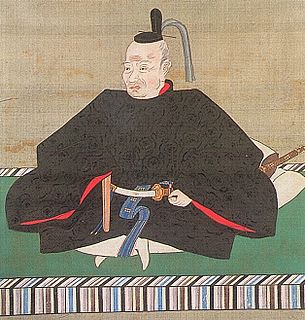See also
- Sanada, Nagano, a former town in Chiisagata District, Nagano Prefecture, Japan
- Sanada Ten Braves, group of ninja
Sanada is a Japanese surname. Notable people with the surname include:

Sanada Yukimura, actual name: Sanada Nobushige, was a Japanese samurai warrior of the Sengoku period. He was especially known as the leading general on the defending side of the Siege of Osaka. Yukimura was called "A Hero who may appear once in a hundred years", "Crimson Demon of War" and "The Last Sengoku Hero". The famed veteran of the invasion of Korea, Shimazu Tadatsune, called him the "Number one warrior in Japan" (日本一の兵).
Inaba is a Japanese surname. Notable people with the surname include:
Sarutobi Sasuke is a ninja who appears in kōdan narrative art and fictional writings. The nickname is generally believed to have been concocted from Meiji to the Taishō period. Some argue he is based on real live personages, such as Kōzuki Sasuke and Sarutobi Nisuke. His family name, meaning "monkey jump", is written with two kanji; saru (猿) is the character for "monkey", and tobi (飛) is the character for "jump". He was known for his monkey-like agility and quickness, especially in trees. Many depictions portray him as having been orphaned and raised by a band of monkeys, therefore giving rise to the monkey-like abilities. He has been described as a superhero ninja, and caused a boom of ninjas in popular culture during the 1910s-1920s in Japan.
Makoto is a unisex Japanese name although it is more commonly used by males.

Sanada Nobuyuki was a Japanese samurai of the Sengoku period. He was the son of daimyō Sanada Masayuki and the older brother of Sanada Yukimura.

Sanada Yukitaka was a Japanese samurai warrior of the Sengoku period. He is known as one of the "Twenty-Four Generals of Takeda Shingen". He was the father of Sanada Nobutsuna and Sanada Masayuki and grandfather of the legendary samurai warrior Sanada Yukimura of whom served Toyotomi clan.

Ueda Castle is a Japanese castle located in Ueda, northern Nagano Prefecture, Japan. At the end of the Edo period, Ueda Castle was home to a cadet branch of the Matsudaira clan, daimyō of Ueda Domain, but the castle is better known for its association with the Sengoku period Sanada clan. It was also called Amagafuji-jō or Matsuo-jō. The castle was designated a National Historic Site of Japan in 1934.
Sanada Nobutsuna was a Japanese samurai of the Sengoku period. He is known as one of the "Twenty-Four Generals of Takeda Shingen".
Shinya (Shin'ya) is a Japanese given name, usually for males. It is pronounced as "Shin-ya", not "Shi-nya". Notable people with the name include:
Ueda, romanized as Uyeda in an old version of Hepburn romanization, is the 60th most common Japanese surname. Notable people with the surname include:

The Sanada clan is a Japanese clan. The Sanada were long associated with Matsushiro Domain in modern-day Nagano (city), Nagano Prefecture.
Nobuyuki is a masculine Japanese given name. Notable people with the name include:
Shingo is a masculine Japanese given name. Notable people with the name include:
Honda (Hondo)listen (help·info) is a Japanese surname.

Samurai Warriors 4, known in Japan as Sengoku Musou 4 (戦国無双4), is a hack and slash game by Koei Tecmo, and sequel to Samurai Warriors 3. Unlike past Samurai Warriors games, this one only has Japanese voice overs.

Sanada Maru (真田丸) is a 2016 Japanese historical drama television series and the 55th NHK taiga drama. The series is named after the Sanada Maru, a fortification defended by Sanada during the Siege of Osaka in 1615. Written by Kōki Mitani, it stars Masato Sakai as the samurai Sanada Nobushige. It premiered on January 10, 2016 and concluded on December 18, 2016.

Samurai Warriors: Spirit of Sanada, known in Japan as Sengoku Musou ~Sanada Maru~ is a hack and slash game by Koei Tecmo through their development subsidiary, Omega Force. It is a spin-off of Samurai Warriors 4, part of the Samurai Warriors series, which in turn is a spin-off of the long-running Dynasty Warriors series, both of which are also hack and slash games. It was released on November 23, 2016 in Japan to coincide with the airing of the climax episode of the ongoing NHK TV taiga drama Sanada Maru. It was released in North America and Europe in 2017.
Chikurin-in (竹林院) was a Japanese noble lady of the late Azuchi-Momoyama through early Edo period. She was Ōtani Yoshitsugu's daughter, then she was adopted by Toyotomi Hideyoshi, before marrying Sanada Yukimura (Nobushige). She is described as having been very beautiful. They had two or three sons and four daughters.

Sanada Yukimura is a fictional videogame character from Capcom's popular action game franchise, Sengoku Basara. He was first introduced in the 2005 hack and slash video game Devil Kings but was renamed "Scorpio" for the North American and European versions. A young samurai serving the Takeda clan, Sanada Yukimura, fights in the Sengoku period to help his clan unify Japan. While the first four games involve his growth as a samurai and deal with him taking over leadership, the spin-off game Sengoku Basara Sanada Yukimura-Den follows the character's backstory. He has also appeared in the series' anime, manga, stage play, and drama CD adaptations.

Chōkoku-ji (長国寺) is a Buddhist temple belonging to the Sōtō sect of Japanese Zen located in the former town of Matsushiro (presently part of the city of Nagano in Nagano Prefecture, Japan. It is the mortuary temple of the Sanada clan, local warlords in the Sengoku period and daimyō of Matsushiro Domain under the Edo period Tokugawa shogunate.